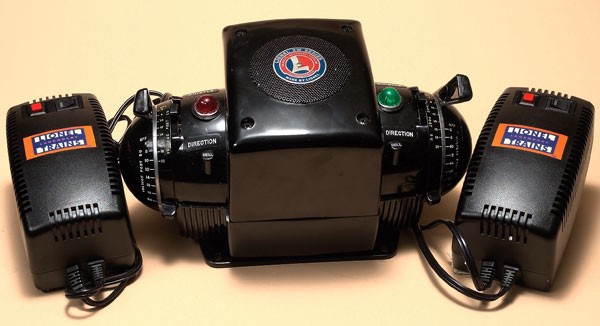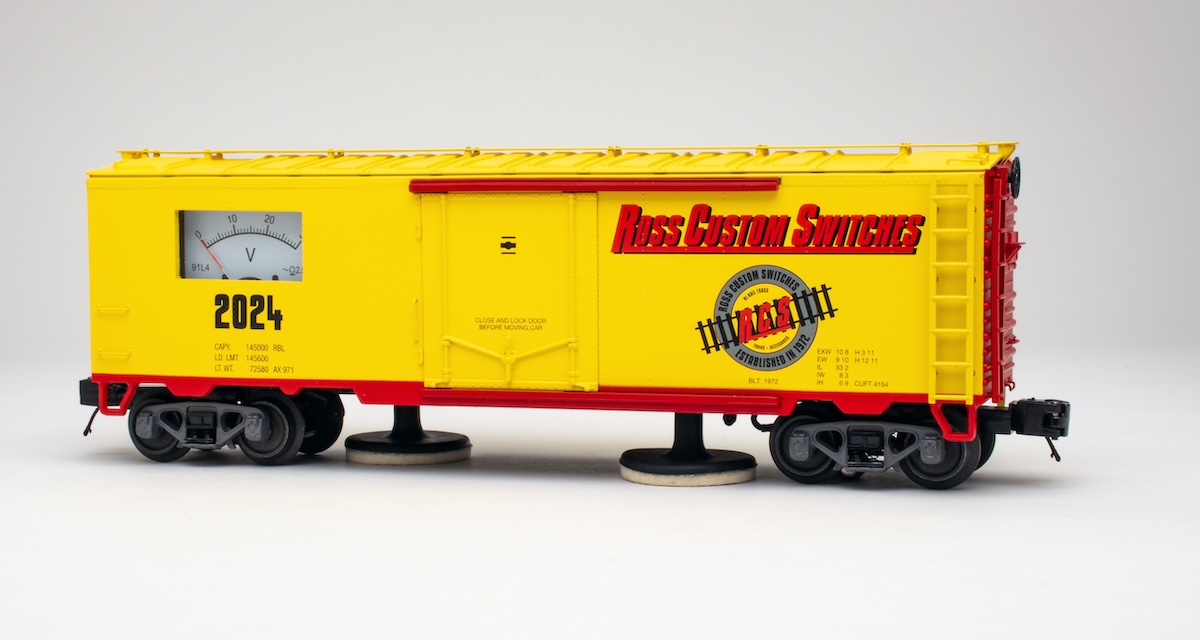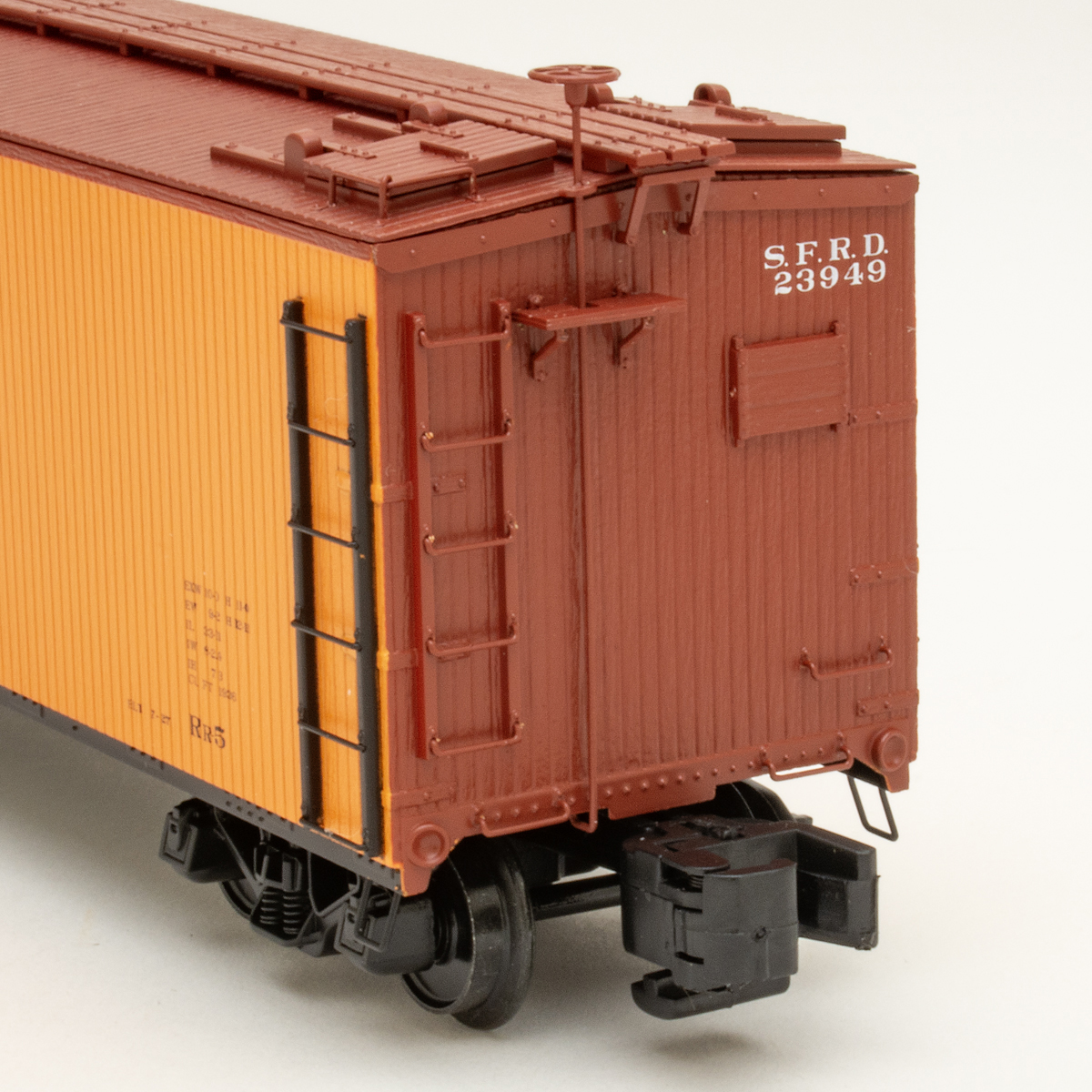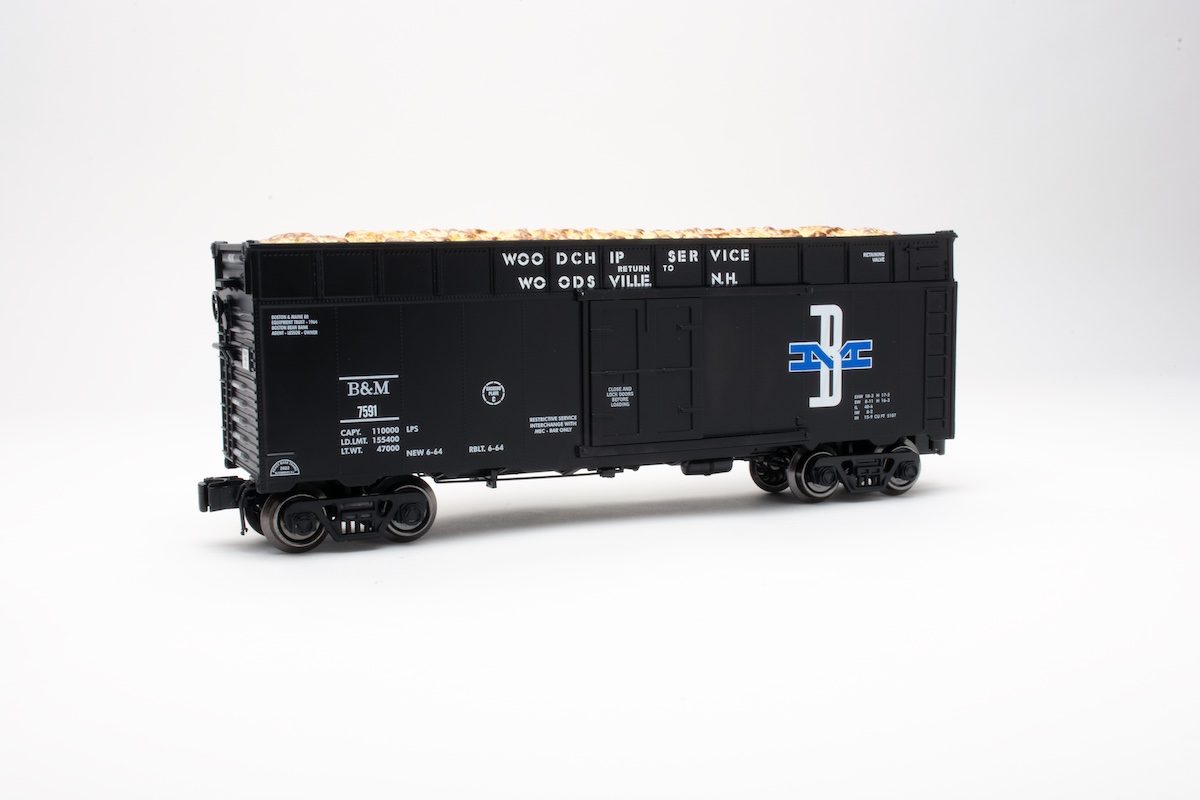Lionel’s new ZW transformer set is both. It is a conventional and command control device that allows you to operate trains 1948-style or 2001-style.
Did I say set? Yes, set. Unlike the postwar version, the new ZW has multiple components. The old ZW is one piece – transformer and throttle mechanisms within an iconic plastic case.
The new ZW is an electronic throttle beneath a postwar skin, but it relies on external transformers for power. Our test ZW is packaged with a pair of all-new 180-watt brick-shaped transformers.
Just like the old ZW, the new has two outer handles and two inner rings that control voltage to a quartet of posts. You can operate one to four trains independently, or use the inner controllers as fixed voltage for accessories. To use all four taps, however, the new ZW requires four input transformers. Your options are a second pair of 180-watters, Lionel’s older design 135-watt PowerHouse transformers, or any other transformers new or old. Note that non-PowerHouse transformers require a Lionel Power Adapter Cable (no. 6-12893) to plug them into the system.
Also note that in order to meet modern safety requirements, you can’t double up 180-watt transformers to put 360 watts to a single electrical circuit. Hence, a postwar ZW can still direct more power to a single line.
The ZW “controller” is a dead-ringer in appearance to the old ZW, except for the discreet addition of a bell pus button. The size and shape of the ZW shell matches the original, and it even feels original since it is made of the same phenolic resin material.
As with the old, matching two-way slide switches work the whistle or direction functions and voltage indication marks are scribed into the bases of the handles. Since the actual transformers are separate pieces, the new ZW controller itself weighs only 5 pounds, 5 ounces and the two PowerHosuses total 14 pounds, 8 ounces.
The new ZW set with 180-watt PowerHouses uses beefy 10.5-amp circuit breakers. It is enough, Lionel says, to run a lash-up of six Lionel Geeps on a single circuit. We tried six Pullmor motors, but 180 watts wasn’t enough to keep the trains moving, although we didn’t pop the circuit breaker.
Although the 180-watt transformers top out at 10.5 amps, using them with older TrainMaster Command Control hardware and command-only lockons limits you to that system’s 7 amps.
The 180-watt PowerHouses, with their distinctive humps, meet Underwriters Laboratories standards. Lionel originally cataloged the transformers at 190 watts. Lionel’s 135-watt PowerHouses are also UL approved.
Conventional mode
In conventional mode, throttles A, B, C, and D operate just like a postwar ZW. Handles set the voltage on terminals A and D; tabbed rings on terminals B and C. All four throttles can be set to different voltages depending on your needs. The threaded terminals around back are just like the postwar transformer, only with up to four plugs heading inbound from the remote transformers, the backside of the ZW controller gets crowded fast.
We ran the most electronically sophisticated (and presumably electronically sensitive) locomotives in the CTT fleet in conventional mode on the ZW looking for any incompatibilities. The roster included an MTH GP38 with ProtoSound and a QS3000 conversion board, an MTH Berkshire with straight ProtoSound, an MTH RS-3 with ProtoSound 2.0, an MTH Dreyfuss Hudson with ProtoSound 2.0, a Weaver RSD-12 with a QSI board, a K-Line Pacific with RealSounds, a K-Line RS-3 with TMCC and RailSounds, and even an MTH RailKing Camelback with a TrainAmerica UCUB board and a QS3000 sound board.
The only glitch was from the Weaver RSD-12 with the QSI board. During one session the locomotive’s bell wouldn’t respond to the bell button, but it would ring by itself when track power dropped below about 8 volts. Testing the Weaver locomotive a second and third time, the bell worked.
The new ZW offers a conventional-mode feature to raise-and-lower track voltage to program the clinks and clanks of pre-2001 MTH ProtoSound locomotives. You’ll need a CAB-1 controller to use the feature.
Command mode
In command mode, the new ZW can perform a multitude of tasks, although its fundamental digital functions do not go beyond Lionel CAB-1/Command Base/PowerMaster/PowerHouse setup (the ZW’s momentum feature differs slightly).
The ZW, however, can put more power to the track since it was built to handle 180 watts and 10 amps per output terminal; the PowerMaster setup was designed for 135 watts and 7 amps.
For command control operation, you need to buy a CAB-1 controller and a Lionel Command Base separately. The ZW controller itself takes the place of Lionel’s PowerMaster unit.
You can operate throttles A, B, C, and D as independent command control circuits, four circuits following a single command, or other combinations including command and conventional mixes. To get power to the track you’ll need to push the ZW handles forward to 18 volts and turn up the CAB-1 throttle as well, sort of a “turn it on twice” function.
Resetting the ZW to reprogram its numerical addresses – there are four – involves pushing a T-shaped plastic tool into a hole in the back of the ZW case. The reset switch doesn’t have much of a feel to it, so we often were unsure if we had pressed the switch properly.
Should your command control layout be large enough to require four electric blocks, you can tap into all four ZW output posts and regulate those posts from a single throttle handle by adding an electrical jumper to the circuitry inside the top of the ZW’s case. It’s a useful feature.
In command mode, we tested a number of Lionel TMCC-equipped locomotives, K-Line TMCC-equipped locomotives, and our RailKing Camelback with a TrainAmerica UCUB board. All operated fine.
Jack of all trades
It’s impossible not to compare the new ZW with the postwar ZW and with Lionel’s original TrainMaster Command Control setup, since the new ZW is designed to take the place of both. But to meet the diverse goals of conventional and command function and postwar appearance, compromises inevitably are made. For the new ZW, the compromise means added complexity to command control operation.
For example, depending on your starting point in command mode, you may need to turn on the power, push the ZW throttle arm forward, turn the CAB-1 throttle clockwise, and address the track. With the original TrainMaster setup, there’s no throttle movement needed; you turn on the power and address the track.
Switching the ZW back and forth from command to conventional modes can involve readdressing the ZW controller with the CAB-1 keypad. On the TrainMaster setup, you physically move a slide switch and keep the same track address.
Monitoring command inputs with the ZW can be accomplished by watching the flicker of the bulb within the sculpted red “fault” lens atop the ZW case. But in bright light it’s hard to see the bulb beneath the lens, unlike the simple red LEDs on the TrainMaster setup. A transformer setup as sophisticated as the ZW should also offer amperage and voltage meters, even if it is a separate unit.
The new ZW is without question the most flexible toy train transformer yet produced. It can power one to four circuits in conventional or command modes with more than enough oomph to handle all but the largest dream layouts you can imagine.
If you’re a conventional-mode guy and want the unadulterated tradition of a ZW transformer with 21st-century safety features, the new ZW is the way to go for layout power.
If you’re a command guy, the ZW will satisfy your needs and more, but you’ll make a trade-off between convenience and esthetics.















For Christmas 2007, Santa brought me a new Lionel ZM transformer with two extra 180-watt power houses to give a combined power output of 720 watts to my "S" gauge hi rail layout of vintage American Flyer. The new ZW came with the optional amp and volt meters that your review of the ZW noted as lacking. The meter panel is an excellent addition to the ZW and it is unfortunate that Lionel has discoutinued the accessory meter add on to the new ZW. This new power source has allowed me to retire my three aged Gilbert American Flyer Model 19B train power controllers and given me the convenience of built-in horn/whistle and bell controls for both throttles. The A and D channels that control train operations do go through add-on S Helper control boxes to operate horn/whistle, bell, and special features on newer motive power. With 0 to 18 volts and 0 to 10.5 amps on each channel available, this new power controller operates everything safely and efficiently. With the 18 volt maximum output limit, it protects the delicate electrical boards in many of my newer S Helper and American Model motive power. Excessive voltage output has been a recurring problem with the original ZW from the 1950's and some of the newer power supplies such as MTH's Z-4000 transformer which cooked several of my S Helper sound boards. Although both your product review and the Lionel instruction manual and catalog descriptions do not go into its conventional mode operations, there must be some type of signal shaping and momentum as my old Flyer engines from the 40's and 50's operate better than they ever did from very slow to prototypical speed operations – no stalling or jack rabbit starts. With modern equipment, four S Helper F3's pulled 12 streamline passenger cars of which five were old Gilbert aluminum models at a scale 75 MPH while the Lionel meters only registerd 3 amps and 10 volts. From a performance stand point, this new Lionel ZW with either two or four 180 power houses has no resemblance to its 50's ancestor except for its classic case and dual throttles!
It would be beneficial in a future issue of Classic Toy Trains to discuss from a technical perspective how this new ZW really functions in both conventional and command modes. The command mode/computer interphase options are going to make toy trains much more interesting and attractive to younger model railroaders.